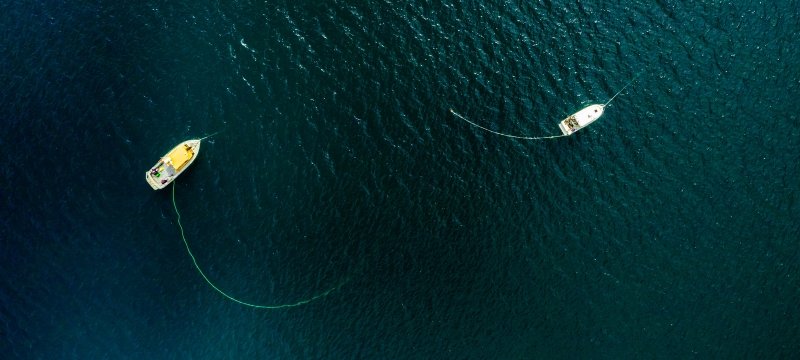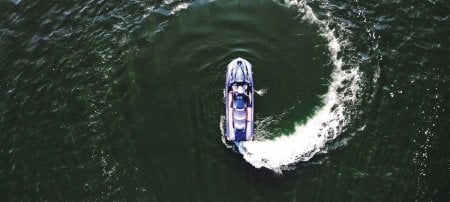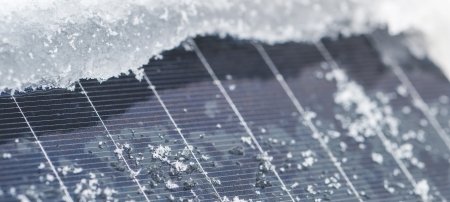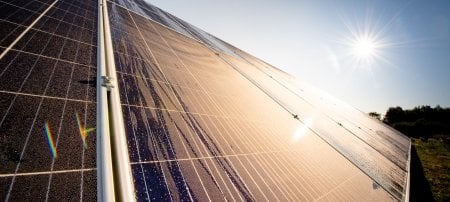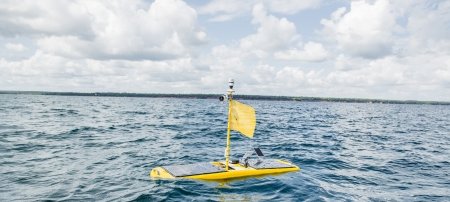Michigan Tech researchers tackle off-the-grid autonomy, navigate unstructured spaces, and peer into the depths of human potential.
Autonomous Data Collection
The autonomous wave glider Camaro rode Lake Superior's wind and waves for nearly a month during late summer 2021, deploying August 30 on a voyage to collect chemical and biological data from the lake.
The glider was deployed by Michigan Tech's Great Lakes Research Center (GLRC) and NOAA's Great Lakes Environmental Research Laboratory (GLERL). It completed its mission on September 22 without a hitch, riding through several storms that had commercial freighters seeking shelter.

Camaro brought back plenty of data to help researchers understand primary productivity—the process that forms the foundation of food webs in most ecosystems—and validate satellite algorithms. But while scientists will learn much from the data recorded by its instruments, the wave glider and its effortless navigation through the rough weather taught them something extra.
"The most important lesson we learned while piloting over the last few weeks is it really loves bad weather; the worse the conditions, high wind and waves, the better the vehicle holds its line and steers to its next waypoint," said Jamey Anderson, GLRC assistant director and head of marine operations. "While it was happily doing triangles near Bete Grise last week, two 700-foot lake freighters were anchored in the bay, hiding from the bad weather and big waves. That is the glider's strength, to be out collecting data when no one else can or would want to be."
Camaro's ease of data collection in potentially hazardous conditions could foreshadow an expansion in the use of autonomous vehicles in Great Lakes marine research.
Solar Energy
In 2021, researchers studying solar photovoltaic (PV) energy at Michigan Tech added substantial findings supporting its use to power households, charge electric vehicles, and heat Upper Peninsula homes in winter.
Researchers developed a new calculation that defines PV's value in terms of avoided costs and liabilities. Using this new equation, they found that solar panels benefit entire communities because homeowners with grid-tied solar panels are actually lowering the cost of energy for their non-PV neighbors.
Researchers also looked at the effectiveness and feasibility of using solar awnings to charge electric vehicles. Their work showed that solar awnings installed in retail parking lots could successfully power charging stations. Additionally, the total parking lot energy potential is vast—the team found that awnings installed at Walmart Supercenters alone across the US could charge electric vehicles for 90 percent of the American public living within 15 miles of a Walmart.
Turning their research closer to home, MTU's PV experts also worked on a pair of studies aimed at winter heating costs in the UP, where costs are some of the highest in the continental US. They concluded that, when used in concert with electric heat pumps, solar PV energy can lower heating bills for an average Upper Peninsula home—while reducing greenhouse gas emissions.
Research on solar PV energy continues to prove its benefits for individual consumers, communities, and the planet.
Undergraduate Research
Economics major Tyler Sepanik studies the labor shortage currently plaguing middle-skill occupations in the US. These are the jobs that generally employ vocational school or community college graduates—welders, machine operators, and paralegals, to name a few. The trouble is, these schools aren't graduating enough students to meet demand.
Sepanik's research, guided by advisor Laura Connolly and funded by a Summer Undergraduate Research Fellowship (SURF), is hunting for the link between the demand for jobs and the lack of vocational and community college graduates. His research has identified a particular audience vocational schools should be looking at. "Nine out of 10 students who drop out of four-year institutions do not choose to re-enroll elsewhere and graduate," Sepanik says. "Vocational schools and community colleges can be a reasonable alternative for these students."
"I chose this research project because my hometown has been having issues with labor for quite some time. The issue was not necessarily due to wages as they continued to increase in hopes of meeting the wage demand in the area. Upon further research I realized that this was not only hurting my hometown but the entire nation."
"The United States has only recently put more importance on the funding of vocational schools and community colleges," says Sepanik. "Often though, we see that this type of educational funding is the first to go when budget cuts are introduced. In order to meet this demand for labor, we need to place more importance on this middle-skill education."
Although Sepanik hasn't yet chosen an industry, he knows what he'd like to do. "I would really like to focus on financial analytics in some capacity," he says.
"College can be a great path for many students; it may not be the best path for all students though, and vocational and community colleges are a great alternative for many people. Tyler recognized this and was really vested in highlighting the labor market opportunities available to those who pursued vocational or community college programs."
Graduate Research
Two Michigan Tech graduate students received Department of Defense Science, Mathematics, and Research for Transformation (DoD SMART) Scholarship awards in 2021.
Casey Majhor
Casey Majhor, a PhD student in electrical engineering, works to implement and improve path planning and navigation for autonomous ground vehicles and robots in off-road and unstructured environments. His advisor is Jeremy Bos.
Majhor's research pits him against the distinct challenges of non-urban environments. "One unique challenge is being able to quickly calculate a traversable route from a start to an end location, which considers the terrain, obstacles, and the vehicle's kinematic abilities," he says. On poorly chosen routes, the vehicle could get stuck, roll, or experience excessive stress.
"Accurately following a planned path is another challenge, which requires accurate estimation of the vehicle's location in the environment," says Majhor. He uses multiple sensors—GPS, light detection and ranging (lidar), and inertial measurement units (IMUs)—to track the vehicle's location.
"The ability to program and control robots or vehicles to move and behave autonomously is so fascinating to me. Specifically, the use of lidar sensors to solve these problems is incredible as well. We use them to create 3D digital maps (point clouds) to represent the environments which our robots use to plan paths and navigate with. The whole process and concept is just awesome to see."
Majhor's research impacts fields such as search and rescue, military, agriculture, and planetary exploration. As a funded SMART Scholar, after completing his PhD he'll continue implementing and improving autonomous ground vehicles for soldier use at the US Army Combat Capabilities Development Command (DEVCOM) Ground Vehicle System Center in Warren, Michigan.
"Everyone who starts along this path is already talented. The people who end up being successful are those who can find the goal far off on the horizon and keep making progress to that goal every day. I think that describes Casey perfectly: naturally curious, dedicated, and an endurance runner doing great work."
Lauren Mancewicz
Lauren Mancewicz, a PhD student in environmental engineering, uses computer simulations to study the impact of rising sea levels and climate change on fresh groundwater for islands. She is advised by David Watkins (MTU) and Alex Mayer (University of Texas at El Paso).

"As sea level rises, the groundwater table will also rise and can cause flooding in lower-lying areas, exposing that water to evaporation and resulting in a loss of fresh water," explains Mancewicz. "This process is called groundwater inundation."
Coastal flooding due to rising sea levels is not a new concept—but groundwater inundation adds a wildcard. "Groundwater inundation has the potential to cause additional flooding and can also reduce the availability of freshwater resources," says Mancewicz. "While my work focuses on islands, this process can also occur in other coastal settings, and with nearly 40 percent of the US and 35 percent of the global population living in coastal areas it's important to understand the potential risks and natural hazards associated with where you live."
"Groundwater is such a critical freshwater source and it is rewarding to be able to work on projects that have such a tangible application and that can positively impact people and the environment."
After completing her PhD, Mancewicz will work with the Coastal and Hydraulics Laboratory at the US Army Engineer Research and Development Center, creating new tools and solving complex emerging problems relating to hydrology.
"Lauren is passionate about environmental justice and sustainability. … In her work, she has done a great job of broadening her skill sets in both field and computational research, as well as gaining experience working in interdisciplinary and intercultural settings. This is unusual for a graduate student, and I believe it will enable her to continue to make important contributions to scientific research and data-driven environmental policy throughout her career."
Michigan Technological University is a public research university founded in 1885 in Houghton, Michigan, and is home to more than 7,000 students from 55 countries around the world. Consistently ranked among the best universities in the country for return on investment, Michigan’s flagship technological university offers more than 120 undergraduate and graduate degree programs in science and technology, engineering, computing, forestry, business and economics, health professions, humanities, mathematics, social sciences, and the arts. The rural campus is situated just miles from Lake Superior in Michigan's Upper Peninsula, offering year-round opportunities for outdoor adventure.
